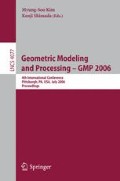Abstract
Automatic detection of features in three-dimensional objects is a critical part of shape matching tasks such as object registration and recognition. Previous approaches often required some type of user interaction to select features. Manual selection of corresponding features and subjective determination of the difference between objects are time consuming processes requiring a high level of expertise. The Curvature Map represents shape information for a point and its surrounding region and is robust with respect to grid resolution and mesh regularity. It can be used as a measure of local surface similarity. We use these curvature map properties to extract feature regions of an object. To make the selection of the feature region less subjective, we employ a min-cut/max-flow graph cut algorithm with vertex weights derived from the curvature map property. A multi-scale approach is used to minimize the dependence on user defined parameters. We show that by combining curvature maps and graph cuts in a multi-scale framework, we can extract meaningful features in a robust way.
Access this chapter
Tax calculation will be finalised at checkout
Purchases are for personal use only
Preview
Unable to display preview. Download preview PDF.
References
Gatzke, T., Zelinka, S., Grimm, C., Garland, M.: Curvature maps for local shape comparison. In: Shape Modeling International, pp. 244–256 (2005)
Gatzke, T.D., Grimm, C.M.: Feature detection using curvature maps and the min-cut/max-flow graph cut algorithm. Technical Report WUCSE-2006-22, Washington University, St. Louis Missouri (2006)
van den Elsen, P., Maintz, J., Pol, E., Viergever, M.: Medical image matching - a review with classification. In: IEEE Engineering in Medicine and Biology, pp. 26–39 (1993)
Bloomenthal, J., Lim, C.: Skeletal methods of shape manipulation. In: International Conference on Shape Modeling and Applications, p. 44 (1999)
Klein, P.N., Sebastian, T.B., Kimia, B.B.: Shape matching using edit-distance: an implementation. In: Symposium on Discrete Algorithms, pp. 781–790 (2001)
Hilaga, M., Schinagawa, Y., Kohmura, T., Kuni, T.L.: Topology matching for fully automatic similarity estimation of 3d shapes. In: Computer Graphics (SIGGRAPH), pp. 203–212 (2001)
Besl, P.J., McKay, N.D.: A method for registration of 3-d shapes. IEEE Transactions on Pattern Analysis and Machine Intelligence 14(2), 239–256 (1992)
Rusinkiewicz, S., Levoy, M.: Efficient variants of the icp algorithm. In: Third International Conference on 3D Digital Imaging and Modeling (3DIM), pp. 145–152 (2001)
Osada, R., Funkhouser, T., Chazelle, B., Dobkin, D.: Shape distributions. ACM Transactions on Graphics 21(4), 807–832 (2002)
Johnson, A., Hebert, M.: Recognizing objects by matching oriented points. In: CVPR 1997, pp. 684–689 (1997)
Ruiz-Correa, S., Shapiro, L.G., Meila, M.: A new signature-based method for efficient 3-d object recognition. In: CVPR (1), pp. 769–776 (2001)
Planitz, B.M., Maeder, A.J., Williams, J.A.: Intrinsic correspondence using statistical signature-based matching for 3d surfaces. In: Australian Pattern Recognition Society (APRS) Workshop on Digital Image Computing (WDIC) (2003)
Mori, G., Belongie, S., Malik, J.: Shape contexts enable efficient retrieval of similar shapes. In: CVPR 1, pp. 723–730 (2001)
Sun, Y., Paik, J.K., Koschan, A., Page, D.L., Abidi, M.A.: Point fingerprint: A new 3-d object representation scheme. IEEE Trans. Systems, Man, and Cybernetics, Part B 33(4), 712–717 (2003)
Yamany, S.M., Farag, A.A.: Surface signatures: An orientation independent free-form surface representation scheme for the purpose of objects registration and matching. IEEE Trans. Pattern Anal. Mach. Intell. 24(8), 1105–1120 (2002)
Takahashi, S., Ohta, N., Nakamura, H., Takeshima, Y., Fujishiro, I.: Modeling surperspective projection of landscapes for geographical guide-map generation. Computer Graphics Forum 21(3), 259–268 (2002)
Mortara, M., Patanè, G., Spagnuolo, M., Falcidieno, B., Rossignac, J.: Blowing bubbles for multi-scale analysis and decomposition of triangle meshes. Algorithmica 38(1), 227–248 (2003)
Maintz, J.B.A., van den Elsen, P.A., Viergever, M.A.: Registration of 3d medical images using simple morphological tools. In: IPMI, pp. 204–217 (1997)
McIvor, A.M., Penman, D.W., Waltenberg, P.T.: Simple surface segmentation. In: DICTA/IVCNZ97, Massey University, New Zealand, pp. 141–146 (1997)
Vivodtzev, F., Linsen, L., Bonneau, G.P., Hamann, B., Joy, K.I., Olshausen, B.A.: Hierarchical isosurface segmentation based on discrete curvature. In: Proceedings of VisSym 2003- Data Visualization 2003, pp. 249–258. ACM Press, New York (2003)
Mangan, A.P., Whitaker, R.T.: Partitioning 3d surface meshes using watershed segmentation. IEEE Transactions on Visualization and Computer Graphics 5(4), 308–321 (1999)
Page, D.L., Koschan, A.F., Abidi, M.A.: Perception-based 3d triangle mesh segmentation using fast marching watersheds. In: IEEE Computer Society Conference on Computer Vision and Pattern Recognition (CVPR 2003), vol. 2, pp. 27–32 (2003)
Gal, R., Cohen-Or, D.: Salient geometric features for partial shape matching and similarity. j-TOG 25(1), 130–150 (2006)
Lee, C.H., Varshney, A., Jacobs, D.W.: Mesh saliency. Trans. Graph. 24(3), 659–666 (2005)
Boykov, Y., Kolmogorov, V.: An experimental comparison of min-cut/max-flow algorithms for energy minimization in vision. IEEE Trans. Pattern Anal. Mach. Intell. 26(9), 1124–1137 (2004)
Boykov, Y., Jolly, M.P.: Interactive organ segmentation using graph cuts. In: Delp, S.L., DiGoia, A.M., Jaramaz, B. (eds.) MICCAI 2000. LNCS, vol. 1935, pp. 276–286. Springer, Heidelberg (2000)
Author information
Authors and Affiliations
Editor information
Editors and Affiliations
Rights and permissions
Copyright information
© 2006 Springer-Verlag Berlin Heidelberg
About this paper
Cite this paper
Gatzke, T., Grimm, C. (2006). Feature Detection Using Curvature Maps and the Min-cut/Max-flow Algorithm. In: Kim, MS., Shimada, K. (eds) Geometric Modeling and Processing - GMP 2006. GMP 2006. Lecture Notes in Computer Science, vol 4077. Springer, Berlin, Heidelberg. https://doi.org/10.1007/11802914_43
Download citation
DOI: https://doi.org/10.1007/11802914_43
Publisher Name: Springer, Berlin, Heidelberg
Print ISBN: 978-3-540-36711-6
Online ISBN: 978-3-540-36865-6
eBook Packages: Computer ScienceComputer Science (R0)

